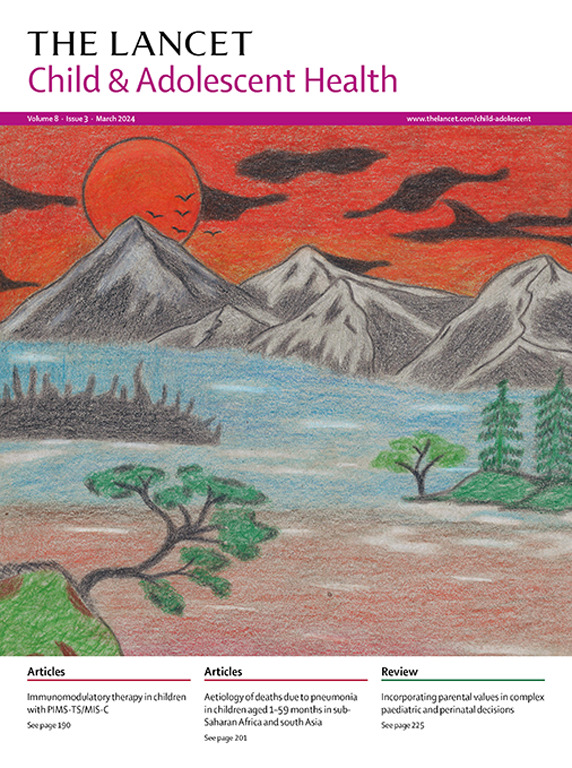Contribution of ethnicity and deprivation to paediatric critical care outcomes in the UK, 2008–21: a national retrospective cohort study
IF 15.5
1区 医学
Q1 PEDIATRICS
引用次数: 0
Abstract
Background
Evidence from UK paediatric intensive care units (PICUs) demonstrates increased incidence of admission among children of Asian and Black ethnicity and children residing in more deprived areas. We aimed to investigate whether mortality in PICU is associated with ethnicity and child poverty.
Methods
This national cohort study included children aged 0–15 years who were admitted to PICUs in the UK between Jan 1, 2008, and Dec 31, 2021. Participating PICUs were affiliated with and reported outcome data to the Paediatric Intensive Care Audit Network (PICANet), from which we extracted data for this analysis. Key exposures were ethnicity, categorised as Asian, Black, Multiple, Other, and White, and area-level deprivation at the time of admission, quantified with the Children in Low-Income Families measure of an area's proportion of children living in families with income less than 60% of the median income and receiving out-of-work benefits or tax credits. The primary outcome was mortality during PICU stay. Mixed-effects logistic regression clustered by admitting PICU centre and individual patient was used to examine the association between key exposures and mortality during PICU stay for all admissions and then separately for planned and unplanned admissions.
Findings
This analysis included 245 099 admissions for 163 163 children during the study period, during which 102 990 (63·1%) had unplanned PICU admissions. 15 017 (9·2%) admissions were for children of Asian ethnicity, 7244 (4·4%) for children of Black ethnicity, 4514 (2·8%) for children of multiple ethnicities, 3831 (2·4%) for children of other ethnicities, and 100 241 (61·4%) for children of White ethnicity. Ethnicity data were missing for 32 316 (19·8%) of admissions. Observed PICU mortality across planned and unplanned admissions was 3·7% (9056 deaths per 245 099 admissions). Crude PICU mortality was highest among Asian children (1336 [5·1%; 95% CI 4·9–5·5] deaths per 26 022 admissions) and lowest among White children (4960 [3·2%; 3·1–3·3] deaths per 154 041 admissions), indicating a higher relative odds of PICU mortality among Asian children than White children for all admission types (odds ratio [OR] 1·52 [95% CI 1·42–1·62]). Odds of PICU mortality did not differ between children of Black and White ethnicity (OR 1·04; 95% CI 0·93–1·15). Children of multiple ethnicities (OR 1·23 [95% CI 1·08–1·39]) and other ethnicities (1·20 [1·05–1·38]) showed increased odds of PICU mortality relative to White children. PICU mortality ranged from 1025 (3·1%; 95% CI 2·9–3·3) deaths per 33 331 admissions for children in the least deprived quintile to 2432 (4·2%; 4·0–4·4) deaths per 58 110 admissions among children in the most deprived quintile, demonstrating an association between PICU mortality and area-level child poverty (OR 1·13 [95% CI 1·03–1·23]).
Interpretation
Variation in PICU mortality by ethnicity and area-level deprivation highlights the importance of further investigation into systemic drivers of disparities in PICU outcomes in the UK. Targeted strategies to mitigate drivers of inequalities are essential.
Funding
None.
种族和贫困对英国2008-21年儿科重症监护结果的贡献:一项全国回顾性队列研究
来自英国儿科重症监护病房(picu)的证据表明,亚洲和黑人儿童以及居住在更贫困地区的儿童的入院率增加。我们的目的是调查PICU的死亡率是否与种族和儿童贫困有关。
本文章由计算机程序翻译,如有差异,请以英文原文为准。
求助全文
约1分钟内获得全文
求助全文
来源期刊

Lancet Child & Adolescent Health
Psychology-Developmental and Educational Psychology
CiteScore
40.90
自引率
0.80%
发文量
381
期刊介绍:
The Lancet Child & Adolescent Health, an independent journal with a global perspective and strong clinical focus, presents influential original research, authoritative reviews, and insightful opinion pieces to promote the health of children from fetal development through young adulthood.
This journal invite submissions that will directly impact clinical practice or child health across the disciplines of general paediatrics, adolescent medicine, or child development, and across all paediatric subspecialties including (but not limited to) allergy and immunology, cardiology, critical care, endocrinology, fetal and neonatal medicine, gastroenterology, haematology, hepatology and nutrition, infectious diseases, neurology, oncology, psychiatry, respiratory medicine, and surgery.
Content includes articles, reviews, viewpoints, clinical pictures, comments, and correspondence, along with series and commissions aimed at driving positive change in clinical practice and health policy in child and adolescent health.
 求助内容:
求助内容: 应助结果提醒方式:
应助结果提醒方式:


